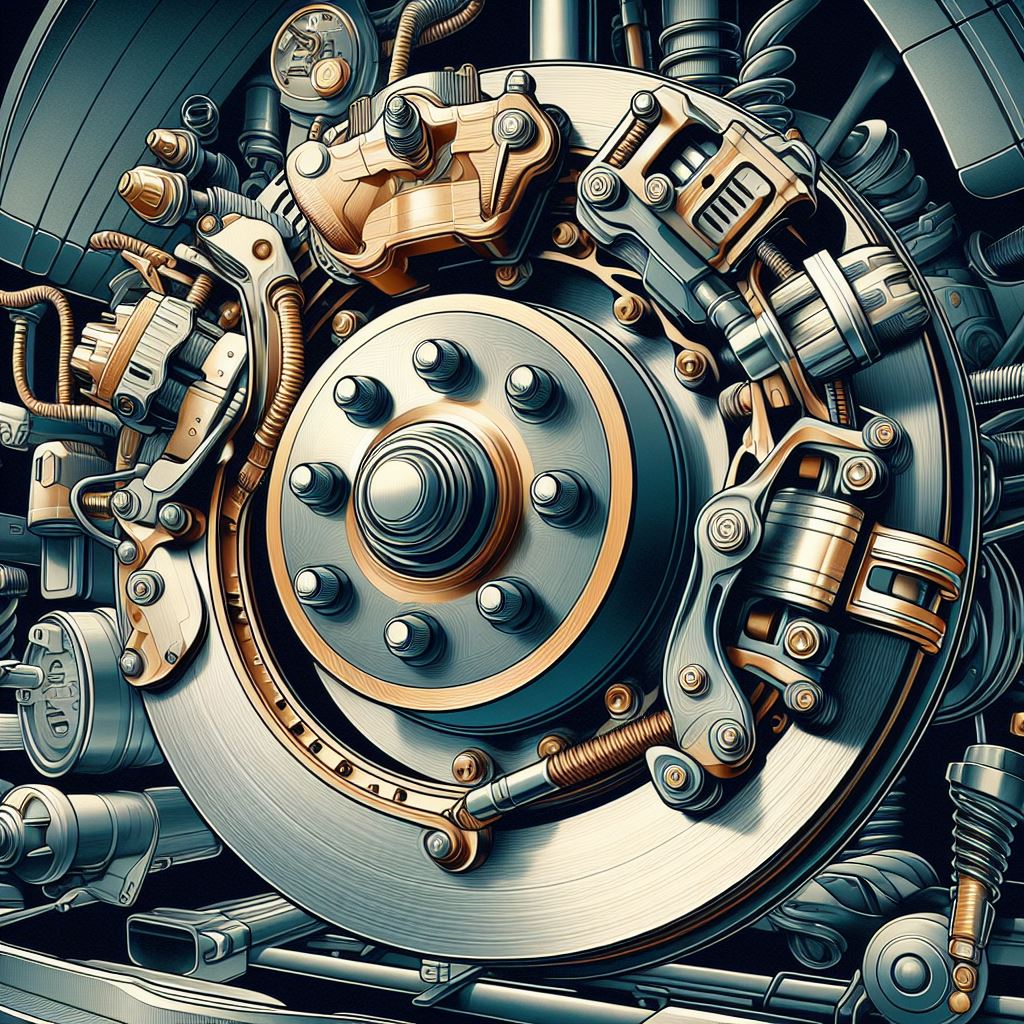What Is The Difference Between Disc And Drum Brakes In A Car?
Brakes are one of the most important components of a car, and they help ensure both our safety and convenience on the road. Without the proper braking system in place, it would be impossible to slow down or come to a complete stop while driving.
The two most common types of brakes are disc brakes and drum brakes. Both have unique advantages and understanding their differences could be the difference between a safe journey and an accident.
Disc brakes work by using two pads that clamp onto a rotor when you step on the brake pedal, creating friction that creates resistance against your wheel turning and slowing down your car.
Thanks to their design, discs provide better performance when stopping from high speeds and higher resistance to wear and tear over time compared to drum brakes due to their increased pad contact area with your wheel surface. Read on to learn more about this matter.
Table of Contents
What is Drum Brakes?
Drum brakes have been an important safety feature of cars since they were first invented by French manufacturer Louis Renault in 1902. Since then, cars have relied on this simple yet efficient braking system to slow them down and eventually bring them to a complete stop.
A drum brake consists of a housing connected to the wheel, two brake shoes inside the housing, and a master cylinder linked to the brake pedal. When the brake pedal is pushed, pressure from the master cylinder causes the brake shoes to rub against the inner surface of the rotating drum.

The friction created between these components helps to reduce speed and eventually brings the car to a complete stop. Drum brakes are mainly used on older models of cars but can sometimes be found on more modern or premium models, usually on their rear wheels. This type of brake has proven its worth over time thanks to its ease of installation and overall simplicity.
Advantages
The advantages of choosing drum brakes for a vehicle are plentiful. The primary advantage is their increased durability due to the increased friction contact area. This ensures they last longer and offer greater car control in various terrains and weather conditions.
Secondly, these brakes come with a much lower price tag, making them an excellent choice for those looking to save money when purchasing a new car or applying brakes to an existing one.
Disadvantages
One of the main problems that arise in drum brakes is overheating. This occurs in high braking conditions, such as when driving down a hill or frequent high-speed braking. Because the drums do not have an outlet to let off heat, they heat up and cause the brake shoes to glaze over or become smooth. This causes them to lose their grip on the drums, resulting in no braking action.
Another issue with drum brakes is pushing the brake pedal further than usual when hard braking occurs. Drum brakes experience thermal expansion, which means it expands slightly under these hard-braking conditions, so you need to press farther down on the pedal for proper braking power.
What is Disc Brakes?
Disc brakes have come a long way since their introduction in the early 1920s. Initially, it didn’t take off due to low technology and high cost. However, its reputation as a reliable brake system grew after Jaguar used disc brakes on its racing car at the Le Man’s 24-hour race in 1953.
It won the race due to its superior braking capabilities. Since then, automobiles have widely adopted disc brakes for better efficiency.
A typical disc brake consists of a rotor, a caliper containing two brake pads that move towards or away from each other when the piston presses and activates the brake pedal. It works on the principle of friction created between the brake pad and rotor, which causes an opposing force resulting in the deceleration of wheel rotation almost immediately.

This type of braking system is far more efficient than drum brakes, which use lever-action forces instead of directly acting against rotating wheel motion like with disc brakes.
Advantages
Disc brakes offer numerous advantages compared to their drum brake counterparts. The major advantage of disc brakes is that they require less effort to engage.
While drum brakes feature mechanical linkage, most disc brake systems are now hydraulic, meaning the amount of effort required to actuate them is significantly reduced and also produces a greater braking force.
Disadvantages
Disc brakes are often touted for their superior stopping power and responsiveness, but they come with certain drawbacks when compared to conventional drum brakes. For one thing, disc brakes are far more expensive than drum brakes.
Additionally, the brake rotors can warp if subjected to high-speed braking or due to improper installation. Also, the brake pads wear out faster in disc brakes due to the powerful squeezing motion of the brake piston on the brake pads, which presents other long-term replacement costs.
What is the Difference Between Disc and Drum Brakes in A Car?
Disc brakes and drum brakes are two common types of braking systems in cars. Disc brakes use a caliper and rotor to slow the car down, while drum brakes use a wheel cylinder, brake shoes, and brake drums to do the same. There are many differences between disc and drum brakes, such as cost, performance, maintenance requirements, installation complexity, etc.
Regarding performance, disc brakes are generally considered to be better. They can provide shorter stopping distances from higher speeds, better resistance to wear and tear compared to drum brakes, and more consistent performance in wet weather conditions.
Disc brakes also offer more control over braking force when applied than drum brakes which rely on lever-action forces. Regarding maintenance requirements, disc brakes require less frequent brake pad replacement, while drum brakes require regular inspection and cleaning to keep them in tip-top shape.
Finally, disc brakes are slightly more complex to install than drum brakes, requiring greater expertise and knowledge.
Which One is Better?
Disc brakes are widely considered the more effective braking system when compared to drums. Due to the many advantages of this technology, most new cars and trucks come with disc brakes installed on all their wheels.
Disc brake systems allow for better-functioning brake pads that dissipate heat more effectively and can run cooler, providing a more reliable response when slowing or stopping. Furthermore, these brakes don’t require manual adjustments and make it much easier to inspect and service them regularly.
Another benefit of disc brakes is cost-effectiveness. Many vehicles still rely on drum brakes, but those looking to upgrade their vehicle can utilize disc brake conversion kits that transition drum-equipped vehicles into those using disc instead.
With these cost-effective kits available today, drivers can experience an improved braking response without sacrificing too much regarding cost.
Frequently Asked Questions [FAQs]
1. Is It Safe To Use Disc Brakes?
Disc brakes are brake systems used in modern cars that provide superior braking performance and safety compared to traditional drum brakes. Disc brakes use hydraulic pressure to squeeze a set of pads against a spinning disc or rotor, creating friction that slows the car down.
The advantage of disc brakes is that they offer superior braking performance over drum brakes, with improved stopping distances and better heat dissipation.
2. Will Disc Brakes Work Better In All Conditions?
Disc brakes offer superior performance over drum brakes in most conditions, but they are not necessarily the best choice for all applications. For instance, disc brakes can be less effective in wet and muddy conditions, as the pads may become clogged with dirt and debris, reducing braking performance.
In some scenarios, drum brakes may provide better control in low-speed maneuvers. Ultimately, the best solution for each application will depend on factors such as the type of vehicle, driving conditions, and terrain.
3. Why are Disc Brakes Best?
Disc brakes are the clear winner when it comes to stopping power. They outperform rim brakes by a significant margin, allowing riders to bring their bike to a halt with less pressure on the lever. This reduces hand fatigue and improves control, ensuring a safer ride.
4. Are Disc Brakes Faster?
Disc brakes are generally considered faster than drum brakes, as the disc brake system is much lighter and more compact. This allows for a quicker response time when the brakes are applied and quicker vehicle deceleration.
Additionally, disc brakes provide more stopping power than drum brakes due to their design. The disc brake system uses one or two rotors connected to a caliper, squeezing two brake pads against the rotor, creating a powerful stopping force.
5. Are Disc Brakes Loud?
Disc brakes are the most common type of brake system in cars, and they generally make less noise than drum brakes. This is because disc brakes have a smaller contact area between the pads and rotors, resulting in a quieter operation. On the other hand, drum brakes have a much larger contact area, which can cause more noise due to friction.
Conclusion
Disc brakes are the superior choice regarding braking performance and safety. They provide more stopping power, better heat dissipation, and faster deceleration than drum brakes. Additionally, they can be cost-effective for those looking to upgrade their vehicle with a disc brake conversion kit. Ultimately, the best choice for each application will depend on factors such as driving conditions and terrain.
